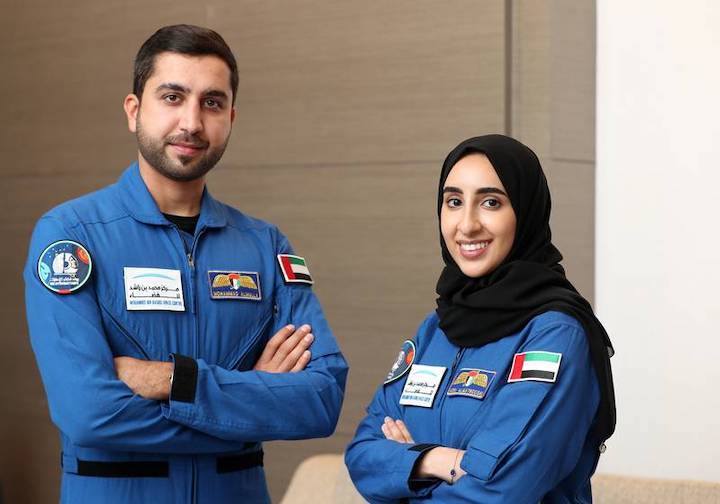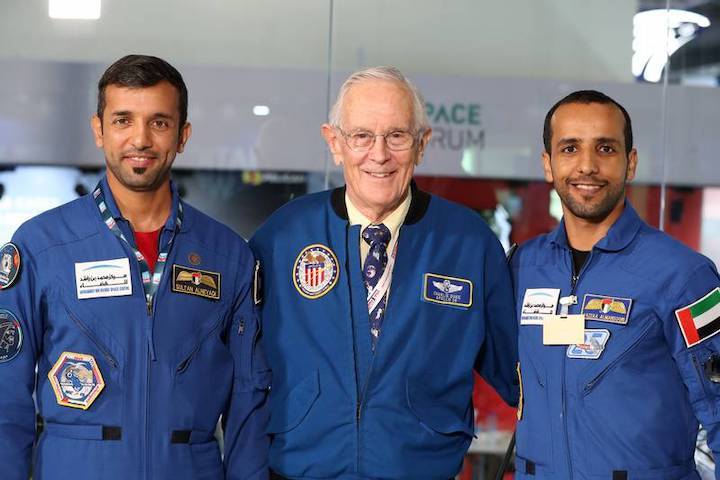22.11.2021
Russian language lessons, spacewalks and flight training await Mohammed Al Mulla and Nora Al Matrooshi

The UAE’s two new astronauts are heading to Houston next week for a two-year training programme.
Mohammed Al Mulla, a former Dubai Police helicopter pilot, and Nora Al Matrooshi, a mechanical engineer, will begin their training in January at the Johnson Space Centre.
They will be trained alongside Nasa’s new class of astronaut candidates, who will become eligible for space missions once they graduate, including to the International Space Station and future missions to the Moon under the Artemis programme.
“They are going to Houston in the first week of December. Nora and Mohammed will join Nasa’s next ASCAN [Astronaut Candidate Selection] class,” Salem Al Marri, the head of the UAE’s astronaut programme at the Mohammed bin Rashid Space Centre, told The National.
Ms Al Matrooshi and Mr Al Mulla will learn the systems of the space station, the Russian language, how to perform spacewalks, robotics, leadership training, and flying T-38 supersonic jets.
Hazza Al Mansouri and Sultan Al Neyadi, the UAE’s first two astronauts, have already completed one year of training and will return to the space centre at the end of December to continue the programme.
“I feel prepared and excited, because I like to think of myself as a very adventurous person. I love the fact that I'll be put in situations I'm not used to. So, I'll be pushed out of my comfort zone. I feel like that's very exciting,” Ms Al Matrooshi, who was selected to be the first Arab female astronaut, told The National in an earlier interview.
The training of the four UAE astronauts has been possible because of a Reimbursable Space Act Agreement Nasa signed with the Mohammed bin Rashid Space Centre in 2020, which means the UAE has purchased access to Nasa’s facility and the training programme.
Once the Emirati astronauts graduate, they would also become eligible for long-duration space missions to the space station.
As for missions to the Moon, the UAE is in discussions with Nasa about being involved in the Artemis programme, which aims to build a sustainable human presence on the lunar surface.
The UAE is one of 13 countries that has signed the Artemis Accords, which outline responsible and peaceful Moon exploration, and pave the way for these countries to become part of future Moon missions.
During the International Astronautical Congress held in Dubai last month, Emirati space officials held meetings with Nasa’s deputy administrator Pamela Melroy, where Artemis was discussed.
“International co-operation on Artemis is intended, not only to bolster our space exploration from a technological standpoint, but also to enhance peaceful relationships between nations,” Ms Melroy said at the conference.
In 2018, an agreement between the UAE Space Agency and Nasa was signed to identify areas of interest within human spaceflight and utilisation of the space station and Gateway – a lunar-orbiting station the US space agency plans to build as part of Artemis.
A growing number of space agencies are focusing on Moon exploration missions as the International Space Station reaches the end of its lifespan.
It has been operational for 20 years, but it is expected the floating science laboratory will retire later this decade because of its aging infrastructure and rising costs of maintenance.
“Obviously, exploring the Moon and Mars are things that we're always looking at and talking about,” Mr Al Marri said.
“So, a natural next progression would be to look at what we can do towards the Moon.”
Private companies are looking to commercialise low-Earth orbit with their own space stations that astronauts and tourists could access.
Apollo moonwalker Charles Duke meets UAE astronauts at Dubai Airshow - in pictures


